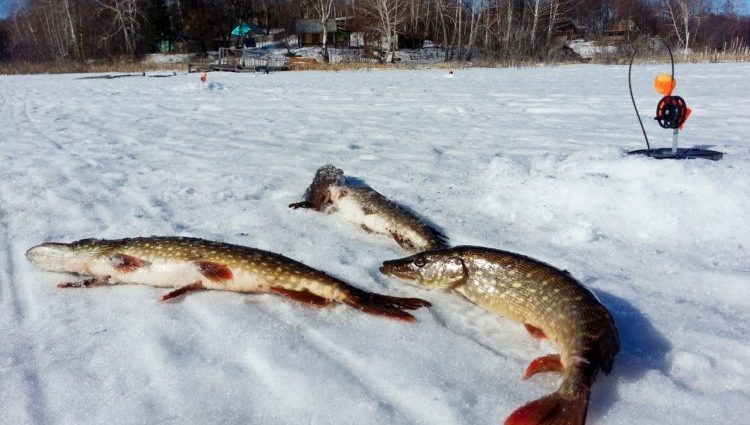содржина
The middle of winter is not the most favorable time for finding a spotted predator. In the second trimester, the oxygen balance of closed water areas is disturbed, and the fish becomes passive. Thick ice negatively affects the bite, but allows you to get to those places that were previously inaccessible. Catching pike in January requires perseverance and knowledge of the habits of a predator. Often, only a trifle comes across on hooks, which indicates either the absence of worthy specimens, or their passivity.
Tactics for finding pike in the wilderness
Every year, the deaf winter comes at a different time. If the winter is warm and the ice does not become until January, there is enough dissolved oxygen to keep the pike active. However, the bite depends not only on this indicator.
The activity of the spotted beauty on the first ice can be associated with the preparation for a long hungry season of freezing, in January, the predator’s interest in the proposed baits drops sharply.
Where to look for pike in the middle of winter:
- Along the banks of the rivers. During this period, the fish occupies relative shallow waters with a depth of up to 2-3 m. Pike keeps on the border of still water and current, sometimes on a weak stream. You will almost never meet her on the rapids, and also in the river bays in the dead of winter there are very few “spotted” ones. The predator enters the bays towards the end of winter, when the pre-spawning period begins.
- In the upper reaches of ponds and lakes. To choose a parking lot, a pike needs several conditions, one of which remains the presence of a food base in winter. The upper reaches of closed reservoirs, as a rule, are shallow, have traces of dying vegetation, in which invertebrates and molluscs hide. The upper reaches attract small fish, followed by perch and pike. Depths there range from 0,5-2 m. Many reservoirs are formed independently or with the help of a person at the places where streams flow, so their upper part is always shallow.
- In large bays of reservoirs. As in the upper reaches of the ponds, bays attract linen, which feeds on pike. One of the favorite “snacks” of the predator is roach and rudd. In large bays, it is necessary to look for zones with drops or explore the edge of cattail, windows in the reeds. Pike can spend the whole winter in thickets, where the ice melts the fastest in the thaw and there is always something to eat.
- On the differences in depths, sharp exits from the pits. Shelters are the second condition for a promising parking lot. In addition to snags and stones, the fish uses relief unevenness, hiding in a pit or on the side of a hillock. Any shallow water in the middle of a pit or channel needs to be caught, because a predator is drawn there in search of small things.
- In snags and fallen trees along the coastline. Twigs and sticks are home to a variety of aquatic creatures that feed on white fish. In the rubble, the pike finds both ambushes and a food base, but it is not easy to get it there.
- Near the confluence of streams, underwater springs and other sources of oxygen. In January, oxygen saturation of water is especially important. The current mixes the water column, increasing the activity of the predator.
When fishing for pike in shallow water with artificial spinners, two principles of drilling holes can be used: 10 holes in one pass or one and a half holes at a time. In the first case, the fishing area receives more noise, but has time for the fish to calm down. As you know, sound travels faster under water, so the work of the drill will be noticeable within a radius of 200-300 m.
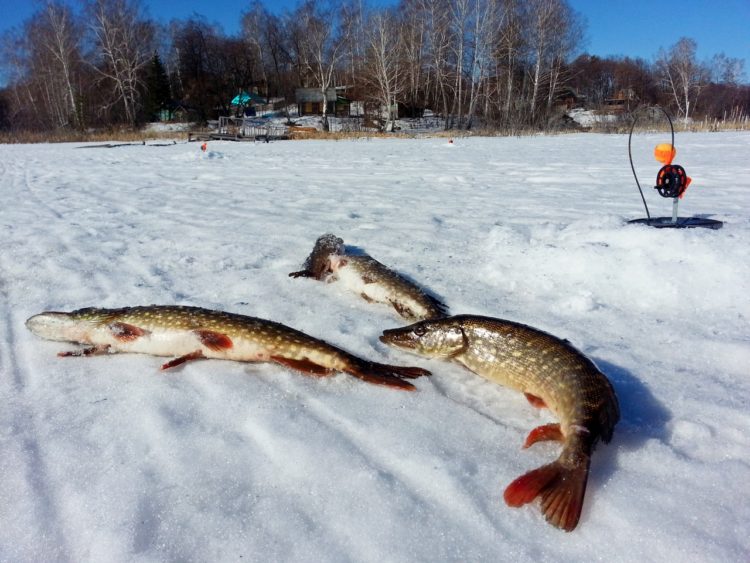
Фото: na-rybalke.ru
If you make one and a half holes, the noise level in the area decreases. The first hole is “beaten” to the end, the next – half or until the last two revolutions. The water area freezes evenly if a stagnant body of water with the same depth is taken into account. On rivers or reservoirs with a sharp change in depth, the hard layer will be uneven.
When drilling the first hole, you need to remember how many revolutions of the auger it took to punch the hole. If the ice is even, the next hole should be drilled 2 turns less than the previous one. On an unevenly frozen pond, holes are drilled 3-4 turns less. This method of drilling reduces the sound level and does not alarm the predator so much.
If, when fishing for perch, they use drilling with envelopes or a straight line, then when searching for “toothy” holes, they make them in random order.
The essence of the search for pike consists of three facts:
- there is no systematic location of the fish;
- drilling takes place around visible shelters;
- if it is not possible to trace promising zones on the water surface with one’s own eyes, they are searched for by changing the relief.
This applies to both lure fishing and the installation of girders. In January, it is important to drill holes as close to shelters as possible. At this time of the year, the fish are passive, and if you do not get under her nose, you can be left without a catch. Underwater observations with the help of installed cameras make it clear that in the dead of winter it is difficult for a predator to travel several meters to the “dancing” bait, especially when he is not sure of its edibility. Provocative types of baits in January work the worst.
Influence of weather on biting, activity during the day
It is no secret that the state of the atmospheric front directly affects the catch. Interestingly, the same weather affects fish differently depending on the season. If in the summer heavy rain can revive the water area, then in late autumn precipitation completely levels the activity of underwater inhabitants.
Pike biting in January is negatively affected by:
- abrupt change of weather;
- changes in atmospheric pressure;
- rain and hail;
- strong wind.
If bad weather lasts for 3-4 days, pike biting is unpredictable: on some reservoirs, there is enough stability for the fish to get used to it and “open its mouth”, on others, the pike refuses even live bait until the cyclone passes.
On frosty days with temperatures below -12°C, the bite is the most active. A slight wind does not interfere with pike fishing if it does not exceed 6 m / s. The gusty streams of air masses make fishing uncomfortable, so the productivity of fishing decreases.
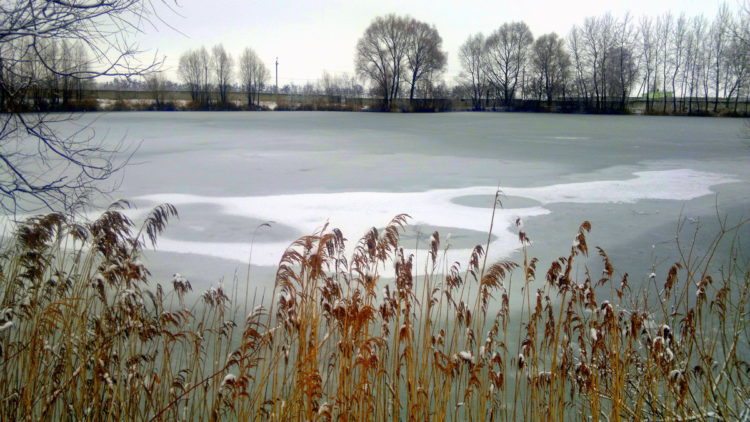
Photo: s3.fotokto.ru
Strong winds during the thaw are not the best time for pike fishing. During this period, the January predator responds mainly to live bait, ignoring balancers and spinners. The lowest possible temperatures also do not bring anything good, only small pike are caught on hooks, all large specimens can leave their usual habitats, going to the depths.
It’s no secret that atmospheric pressure is directly related to the weather. Many anglers buy a mechanical barometer in order to keep abreast of things on the pond. It is worth noting that camping devices are much more efficient, because they transmit readings in the area where the angler is located. Home instruments may be inaccurate if fishing is planned in distant waters.
Depending on weather conditions, pike can take in the morning, afternoon or evening. Many anglers believe that the “spotted” is not active at night, but the results of night fishing on vents suggest otherwise. At night, a trophy pike comes across, even if a trifle pecks at the same place during the day.
The peak of toothy activity is in the morning and evening hours. She begins to actively feed immediately after dawn. As a rule, the exit lasts an hour and a half, in the evening it can be shorter.
The subtleties of fishing for pike in January
In the second trimester of winter, the tackle for catching a predator is slightly modified. Now, instead of steel leashes, many tooth hunters are switching to thick fluorocarbon. This also applies to bait fishing and lure fishing.
sheer glitter
For pike fishing, you will need a meter-long composite or carbon fiber rod. Graphite, due to its flexibility and strength, perfectly dampens the jerks of fish, not letting it into the reed. Fiberglass, a material for the production of budget fishing rods, is suitable only for novice anglers. It is elastic, but does not convey the delicate poking of a passive predator.
In the dead of winter, sharp bites should not be expected, the pike often picks up the bait in the thickness, clings to the very edge of the lip, so the presence of a sharp hook on the bait is a prerequisite for effective fishing.
As bait use:
- балансери;
- ратлини;
- проѕирни бабури;
- силикон за јадење.
One of the most popular baits for winter fishing is the balancer. Its ability to move in a figure-of-eight attracts a predator from afar. In January, bright baits and sweeping postings should be abandoned. Fishing with a balancer in natural colors will bring a much better result. Small strokes, swaying in the thickness, hitting the bottom – all this attracts the predator. For pike fishing, you need to select smooth animation. The most popular size of artificial fish is 7 cm. The mass of these models varies between 10-15 g. It is undesirable to remove the hanging hook from the balancer, otherwise 50% of bites will not be realized.
Even lures in natural colors can have an attack spot on the body or on the hook. It attracts the attention of the pike and serves as a target. If the balancer has a bare tee, it must be replaced with a hook with red cambric, epoxy drop or plumage. The modification will increase the number of bites and the percentage of their implementation.
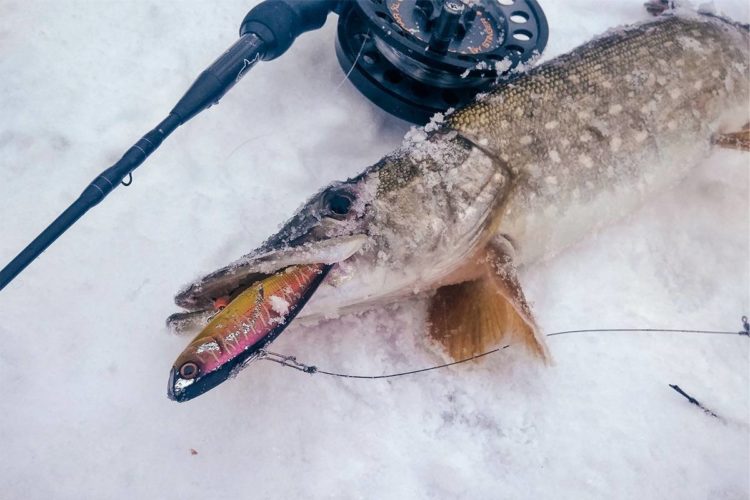
Фото: activefisher.net
Rattlins or vibs are another type of effective nozzle for vertical lure. Their design is assembled in such a way that the bait plays on the smoothest animation.
Vibs were originally developed for casting by Rapala. The first bait of this type was Rapala Rattlin or a bladeless wobbler for fishing for pike perch and pike (maskinong).
Rattlins for ice fishing do not have noise capsules that scare away cautious predators. The by-catch often includes perch.
Effective rattlin colors for fishing in January:
- gray with black or blue patches;
- yellow with green back and white belly;
- dark blue with black back;
- gray-brown or gray-yellow.
A separate item should be noted red and white colors. This type of bait works great at the beginning, in the middle, and at the end of winter. Although there are no universal nozzles, this coloring is closer to the concept of “for any fishing conditions”.
If the balancers have a sweeping game and their use is impossible in “strong” places where the January pike often lives, then rattlins are able to explore such zones, just like sheer spinners.
Vertical lure for pike has a number of parameters:
- more rounded shape;
- planning structure;
- size from 7 cm;
- with a sharp triple hook suspended on a ring.
Planerki attract the attention of a predator from afar, they gleam in the sun, waving from side to side. The wiring of the vertical spinner should also be smooth. Slow rises alternate with pauses up to 10 seconds. You need to wait until the spinner stops completely. In clear weather, anglers use baubles painted in a dark palette; on cloudy days, metallic shades show themselves well: gold, silver, copper and brass.
One of the most popular vertical spinners is the Atom. This model was originally used for casting, after which it was also used in sheer fishing. Another effective glider bait is the Swedish pimple.
A non-classical type of bait for sheer ice fishing is edible silicone. Its effectiveness in catching a predator with spinning made many anglers experiment in winter. The soft structure with the addition of attractants and oils does not freeze at low temperatures, and the bait does not lose its attractiveness.
Silicone when fishing from ice has a lot of advantages:
- A pecked pike does not release it immediately from its mouth, because it has a taste, smell and soft body.
- Both passive and active rubber can be animated in a variety of ways. For winter, light swaying in the thickness, lowering to the bottom and smooth swings are the ideal type of wiring.
- A wide range of colors and shapes of edibles allows you to select the most suitable nozzles for certain fishing conditions.
For winter pike fishing, twisters, vibrotails, and slugs are used. Less commonly used worms, crayfish. Edible silicone differs from ordinary rubber by the addition of oils and attractants. For winter fishing, it does not matter if the products are floating, since the lure is carried out vertically. Pike attacks follow in the bottom layer or a meter from the bottom.
The winter bait is equipped with a double hook, since the probability of meeting a hook is noticeably reduced. Silicone allows you to catch snags and blockages of trees, windows in reeds and cattails, grassy irrigation, where a water lily grew in summer.
Features of fishing on zherlitsy in January
In the middle of winter, fish move little, so search tactics are the surest solution to successful fishing. It is necessary to arrange gear right next to the shelters, unlike the first and last ice, when the pike is active and can overcome good distances, in the dead of winter it is inert and remains in ambush until the last.
On public waters, no more than 5 tackle with one hook per person is allowed. The use of girders above the permissible norm is prosecuted by administrative responsibility and a considerable fine. In private waters, the number of permitted gear is set by the local administration.
The design of the zherlitsa for pike in the dead of winter:
- round or square platform;
- high rack with a bright flag;
- tightened coil without free play under the weight of the sinker;
- fishing line with a cross section of 0,35 mm;
- meter leash made of fluorocarbon 0,5 mm;
- double hook for threading under the gills.
The base should completely cover the hole so that sunlight does not enter the fishing area. In January, a layer of ice is shrouded in snow and subdued light reigns underwater. If the live bait is illuminated by a column of daylight, this may alert the predator.
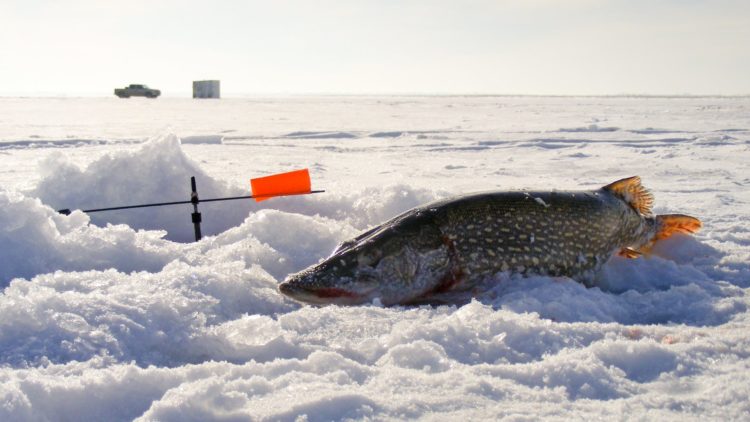
Photo: winter-fishing.ru
A high stand allows you to leave the vents for the night, to catch in severe frost. With its help, the vent can be buried with snow so that it does not allow the hole to freeze through. In this case, the coil is above the snowdrift and the tackle remains fully operational.
If the predator makes a sharp jerk to the side, an unadjusted coil will throw loops that will tangle and the pike will get off. The free movement of the reel must be limited by jerks of the fish.
A rig with a longer leash allows you to cut it if necessary. After each capture, the material should be checked for deformation by the teeth of a predator.
At depths up to a meter, the tackle does not require the installation of a sinker, the live bait is lowered into the hole and it moves freely on a piece of fishing line. In the course, lead weighing 5-10 g of a sliding type is used. When biting, it falls to the bottom, passing the fishing line through itself, without offering resistance.
In the middle of winter, it makes sense to leave tackle at night. The vents are checked either every few hours or in the morning. Biting is periodic: pike can respond until midnight or after, and can also peck only before dawn. For night fishing, it is recommended to return to metal leashes, since it is not known how long the fish will be on the hook. The use of fluor is fraught with cuts, there have been many cases when, when checking vents, anglers took out only part of the equipment.
Suitable as a nozzle:
- руд;
- small carp;
- сребрена платика;
- роуч.
Rudd is considered the best live bait for pike. A small fish actively behaves on the hook, it is noticeable from afar due to its color and is included in the diet of the spotted beauty. Next on the gradation scale is crucian carp. It is used in different water bodies, but it is best to put crucian carp where it is found. Guster and roach are used if there is no other more suitable fish for bait.
It is highly recommended not to use prickly fish species such as perch or ruff. The pike reluctantly bites on the “striped” in reservoirs with white fish, but if fishing is carried out in lakes where the perch is the bulk, then the “sailor” will be the best bait.
They put the live bait on the pike under the gill. In this case, the hook is located in the head area, and the pike, turning the live bait with its nose to the esophagus, swallows the metal part of the equipment. Also known methods of attachment under the fin and the lip. A triple hook cuts through fish worse than a double or single hook.
January fishing for the spotted robber will be successful if you choose the right place, tackle and fishing tactics. Combining girdles with sheer luster will give more results than using only one type of fishing.
Fishing in flowing waters
Small and large rivers attract pike hunters the most. By mid-January, as a rule, even large rivers are frozen, allowing you to explore the water area for the presence of a predator.
In large rivers, pike should be looked for in the following areas:
- shell rock and sandy exits from the pits;
- eyebrows, rocky ridges;
- on long shallows, which are overgrown with grass in summer;
- in bays, at the confluence of small rivers.
It is no secret that the larger the body of water, the larger the fish that can be caught there. You can also meet trophy pike on the river in January, the main thing is to be prepared and have a pick with you to drill a hole. The hook will not be superfluous.

Фото: activefisher.net
When fishing on a large river, the vents are set in one series within sight. Every hour and a half, it is necessary to check the gear, rearranging them to the next promising zones. It is impossible to catch with a sheer bait in a section with vents. Excessive noise will only scare away the capricious winter predator.
For ice fishing on a large river, heavy types of artificial baits are used. Balancers weighing 15 g are not uncommon. In shallow waters, unshipped rubber in transparent shades of lilac, blue, and orange is often used. The method of fishing for a translucent fish without a sinker is effective when catching the most passive pike in shallow waters. With such a lure, they explore windows in the reeds, the edge of cattail, snag. Over time, you can re-pass through the same holes.
On small rivers, pike occupies the following areas:
- крајбрежни рабови;
- backwaters and small open bays;
- the near bank of the turns of the rivers without a current;
- zone of reeds and cattail, grassy watering.
It makes no sense to leave vents for more than 40 minutes on small flowing reservoirs. The constant search and movement of tackle gives results on frosty January days. With the help of a sheer baubles, the coastline of the reservoir is explored: the edge, shallows, beaches, grass irrigation. On small rivers, pike up to a kilogram is most often found, so the size of the spinners must be chosen appropriately.
Catching a predator on ponds and lakes
Standing ponds are not so promising in the middle of winter, however, they are also visited by anglers. In warm winters, the rivers do not freeze, and therefore it is necessary to explore shallow lakes, swamps, private and wild ponds.
It is not easy to find a pike on stagnant water bodies, especially when there are no visible shelters for a predator. It is easier to start fishing from the upper reaches, where the spotted robber has a food base and shelters in the form of cattail. You can also explore the differences in depths, edges, if any, on the reservoir. Private waters are often a flat plateau, where there is nothing to cling to. Experienced anglers advise placing vents near the platforms, along the reeds and in the upper reaches, on narrowings and drops, if they can be found.
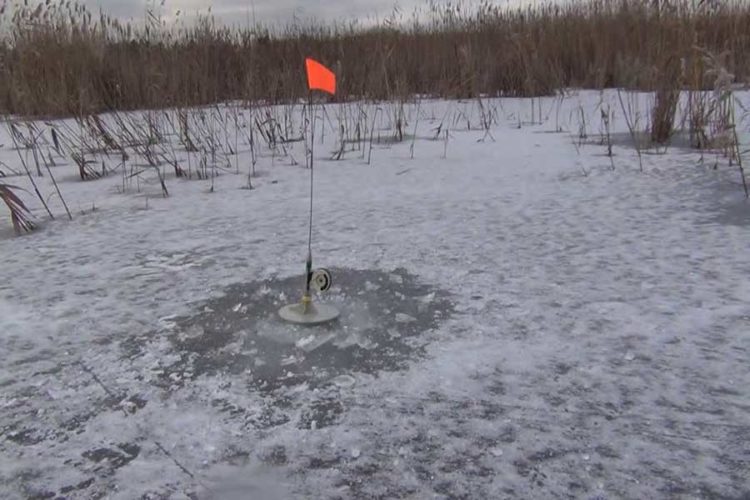
Фото: rybalka2.ru
You can also navigate according to the readings of the echo sounder: a flock of small white fish cannot be missed by a predator, which means that the pike is kept somewhere nearby and the live bait can be safely installed in this area.
On lakes and swamps, which in the warm season are completely overgrown with hornwort and water lily, there is a chance to get a lot of bites. As a rule, such reservoirs are inhabited by perch, pike, rudd and crucian carp, forming a small ecosystem. White fish do not bite there during the freezing period, so you should bring live bait with you.
Zherlitsy exhibit not far from the cattail, if the depth allows. Many swamps completely or partially freeze through, so the minimum column of liquid water should be at least 30-40 cm.
It is worth remembering that small reservoirs slowly replenish fish stocks and it is inhumane to take every caught predator. Pike hunters often release the fish if the water needs it.
Reservoir research
It is much more difficult to find a predator in a large water area than in a small lake or river. Here, kilometers of expanses of water may not be inhabited by any fish at all, especially in winter, when the linen gathers in flocks and goes to the depths.
Ветувачки области за риболов:
- large shallow bays;
- sandy beaches;
- edge of reeds or cattail;
- bumps and drops;
- shell rock, sandy spits.
Fishing on the reservoir is like fishing on a large river. Trophy pike often occupies the old river bed, on which the reservoir was built.

You need to start fishing from shallow waters, a depth of 0,5 m will be enough. They expose baubles near visible promising places, they catch the same principle with the help of vertical baubles. On reservoirs and any other large water areas, the choice of search bait plays a huge role.
A bright lure with a sweeping game can seduce an active predator, provoke him to attack. One ambush is occupied by only one copy of the predator, but there can be many pike in the zone. Its amount depends on oxygen, food supply and shelters. When the spotted beauty leaves her hiding place, another individual takes it. Thus, anglers manage to carry out successful fishing in the same part of the reservoir all year round.










